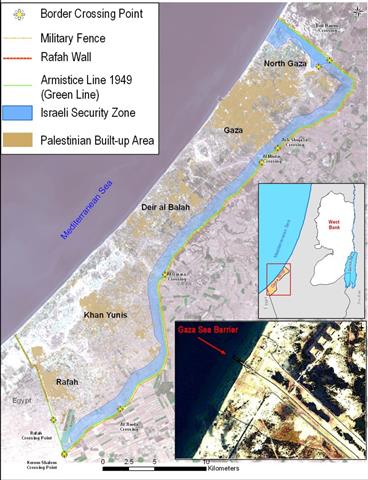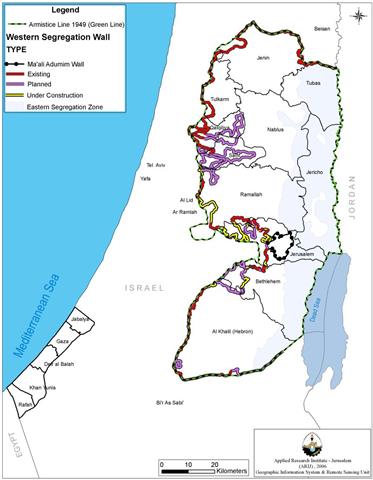Background:-
Geographically, the Gaza Strip forms the westernmost part of the Palestinian territories, bordering Egypt on the south-west, Israel on the north and east, and on the west by the Mediterranean Sea. The Strip's borders were originally defined by the 1949 Armistice Lines (also known as the green line) between Egypt and Israel after the 1948 Arab-Israeli War, which followed the dissolution of the British mandate over Palestine. Gaza was administered by Egypt until it was occupied by Israel in the 1967 Six-Days War. In 1993, and after the Palestinian-Israeli agreements known as the Oslo Accords, the majority of Gaza came under limited Palestinian Authority control. The Accord calls for the withdrawal of Israeli forces from parts of the Gaza Strip and the West Bank and affirm the Palestinian right to self-govern within those areas through the creation of the Palestinian Authority. Moreover, Palestinian rule would last for a five years interim period during which a permanent agreement would be negotiated (beginning not later than May 1996, after the Palestinian legislative Council election held in March 1996). Furthermore, the signed accord gave Israel authority over external security, and for internal security in Gaza and the West Bank. Israeli military forces and civilians would be allowed to continue using roads freely within the Gaza Strip and the area of Jericho.
The Gaza strip is a small isolated 'strip' of land on the Mediterranean coast of historic Palestine, and its total area reaches to (362+Km2). The Palestinian population of this tiny strip is 1,448,416 million residents (PCBS, 2006) making it the most heavily populated area on the planet. This is one of the primary reasons why Gaza need to have free access to the outside world; otherwise, the borders of the Gaza Strip constitute Walls to a vast open-air prison with no means of sustainability.
Israel’s Unilateral Disengagement (Redeployment) in Gaza Strip and North of the West Bank:
When the time slot for the debatable voluntary Israeli evacuation from 21 settlements in the Gaza Strip and four settlements north of the West Bank expired on midnight Tuesday; August 17, 2005, only 855 ( 55 %) settler families has chosen to willingly leave, out of the 1550 settler families living in Gaza. In the four settlements north of the West Bank, 63 (90%) of the 70 Israeli families living there did evacuate the settlements by the period set by the Army.
After the unilateral Israeli withdrawal from Gaza Strip in September 2005, it declared the Gaza Strip a foreign territory, and no longer under the Israeli occupation, Israel still controls all of Gaza's lands, sea, and air.
Why is itRedeployment and not Disengagement
The answer is simple. Following the 1994 Oslo Accord signed between Israel and the Palestinian Liberation Organization (PLO), the status of the Israeli existence there were organized according to an agreement between the two sides aiming eventually at a complete Israeli withdrawal from the 37% of the Gaza Strip’s area, which includes settlements’ areas, security zones, and military bases. These areas the Israeli had a tight control over, including the 8% (29 Km2) that was designated as a 500-meter wide security belt around Gaza’s northern and eastern border. However, and with the second Intifada in the year 2000, Israel has taken it upon itself unilaterally to increase the width of the security belt around Gaza and by the time and at the time of the disengagement in 2005, the width of the security belt ranged somewhere between 800-1300 meters occupying 17% (61 Km2) of the Gaza’s area. So it is easy enough to conclude that the Israeli government did nothing more than rid the Israeli budget from an overhead and money drainage expense (the Israeli settlements in Gaza), but more than that an opportunity to organize the Israeli Army through redeploying the troops around Gaza.
In June 2007, Israel; unilaterally and for the second time went to increase the width of the security belt around Gaza to set it at 1500 meters width, hence taking control of 24% (87 Km2) of Gaza and keeping it under the control of the Israeli Army.
Accordingly, it is easy enough to easy that what Israeli did in Gaza is nothing more than a redeployment of its troops rather than disengage from Gaza; as remains an belligerent occupier more than ever before. See map 1
Moreover, why Israel is still occupying the Gaza Strip
-
Gaza's Population Records:at the time Israel claim that the Gaza Strip is no longer its responsibility as an occupier, Israel still insist to maintain record of all the population status there; getting in or out of Gaza, death and birth records and all that is related to them. Israel claims that it needs the information for security purposes.
-
Gaza's Airspace: Israel remains in total control of Gaza’s airspace and even though the airport in Gaza is not functional by Israeli demand, in fact the Israeli Army made sure of that by striking it repeatedly with missiles. Again, Israel claimed that it destroyed the airport in Gaza and would not allow Palestinians to use for security reasons.
-
Gaza's Seashores: The Israeli Army controls Gaza’s territorial water by keeping its navy ships on guard along the Gaza shores year round. Palestinian fishing boats access to the sea is random and not based on an agreement as the Israelis are the one to identify the time when fishing boat are allowed to go to the sea assuming they are eligible to receive a permit from the Israeli authority. Around 3,000 Palestinians working in the fishing industry have their livelihood threaten because of this. Israeli ships fire upon many of them, when out doing legal fishing. In addition, Israel still denies Palestinians to construct the seaport under the pretext of security. It is worth mentioning that the Oslo Accords allow Palestinian anglers to go fishing up to 20 nautical miles away from the seashore but this is all on paper.
Gaza's commercial terminals: Israel is still in control of six terminals used for individuals or commodities going in and out of Gaza. All of these Terminals fall under the complete control of Israel except the Rafah border terminal. The six terminals are Beit Hanun (Erez), Ash- Shuja'ia (Nahal Oz), Al Mintar (Karni), Al Qarara (Qisoufem), A-Awda (Sofeh), and Karem Abu Salem (Kerim Shalom). However, Rafah Border terminal at south of the Gaza strip is under the Palestinian Authority control with European supervision and Israeli surveillance.
Related Case Studies:
-
The Massive Israeli Operations against the Gaza Strip. August 9, 2006.
-
Israel and the Methodic House Destruction Policy in the West Bank and Gaza Strip. September 17, 2006.
-
The Strangulation of the Gaza Strip. October 1, 2006.
Prepared by
The Applied Research Institute – Jerusalem
ARIJ













